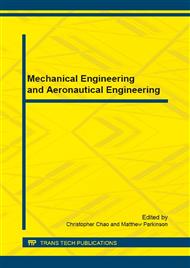p.21
p.29
p.35
p.41
p.46
p.55
p.61
p.66
p.73
Space Vibration Simulation Test of Vapour Compression Heat Pump
Abstract:
Vapour compression heat pump will have good prospects in future large-scale spacecraft thermal control technology. Its environmental reliability and safety needs to be tested on the ground before being carried with the spacecraft launch. Vibration test is used to assess the anti-vibration capability in its transport and use. It is essential to build a performance test system of vapour compression heat pump to explore its operating characteristics at a given random vibration conditions. The results shows that the vapour compression heat pump is normal operation after the vibration and the cooling performance (COP) of 3.09 is achieved. Vibration test is equipped to provide a guarantee for future success carrying. The performance of vapour compression heat pump at high and low temperature and vacuum environment will be carried out.
Info:
Periodical:
Pages:
46-51
Citation:
Online since:
March 2016
Authors:
Price:
Сopyright:
© 2016 Trans Tech Publications Ltd. All Rights Reserved
Share:
Citation:


